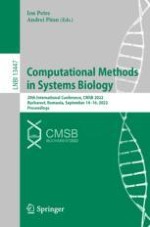2022 | Buch
Computational Methods in Systems Biology
20th International Conference, CMSB 2022, Bucharest, Romania, September 14–16, 2022, Proceedings
herausgegeben von: Prof. Ion Petre, Andrei Păun
Verlag: Springer International Publishing
Buchreihe : Lecture Notes in Computer Science
